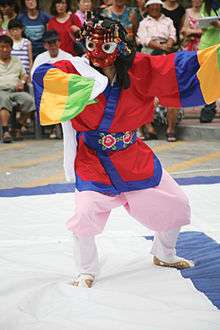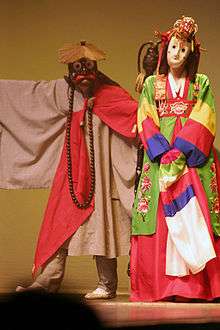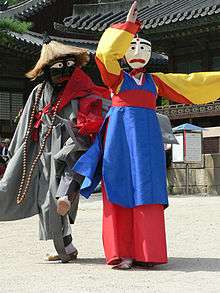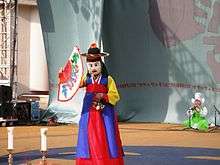Talchum
Talchum (탈춤) or t'alch'um could be characterized as a Korean dance performed while wearing a mask, mimicry, miming, speaking and even sometimes singing. Although the term talchum is usually taken to mean all mask dance dramas by most Koreans, it is strictly speaking a regional term originally only properly applied to dances of Hwanghae Province in present-day North Korea. Dances from the Seoul or Gyeonggi Province region are known as sandae noli, whereas the dances from the southern coast are known as yayu(야유) which means field play or Obangsinjang which means dance of five gods. However, Talchum is nowadays accepted as a general term for mask dance drama.[1]
| Talchum | |
 | |
| Korean name | |
|---|---|
| Hangul | 탈춤 |
| Revised Romanization | talchum |
| McCune–Reischauer | t'alch'um |
Korean mask dance dramas are not just dances performed by masked dancers but also include significant dramatic content with masked characters portraying people, animals and sometimes supernatural beings. These folk dramas reflect the frustrations felt by the lower classes towards the Confucian literati Yangban, due to the latter's treatment of the commoners, show the life of the common man and process social problems such as monks who ignore their precepts and men who cast off their old wives.
History
Talchum originated in Korean villages as part of shamanic rituals that had evolved to cleanse houses and villages, offer protection and good harvest. It then became a form of popular entertainment. It was once performed at the court – during the Koryo dynasty, the Office of Masked-Dance Drama (Sandae Togam) supervised such dances, and these dances may be performed at royal banquets. The office however was abolished during the Choson dynasty.[2]
Themes and characteristics
Mask dance dramas share fundamental characteristics, even though they vary considerably according to region and performer. Their basic themes are exorcism rites, ritual dances, biting satire, parody of human weaknesses, social evils and the privileged class. They appeal to the audiences by ridiculing apostate Buddhist monks, decadent upper classmen, and shamans. Another popular theme is the conflict between an old wife and a seductive concubine. With regional variations, the mask dance drama was generally performed on the First Full Moon, Buddha's Birthday(석가탄신일) on the Eighth of the Fourth Moon, Dano Festival(단오) and Chuseok. Variations may have been performed at festive state occasions or at rituals to supplicate for rain. The enthusiastic participation of the audience is the most remarkable feature of Korean mask dance drama. There is little distinction between the actors and the audience toward the end of a performance, as they join together in robust dance and bring it to a finale.[3]
Procedure
Mask dance is largely divided into seven parts.
The first chief's(상좌,Sang-Jwa) dance is a ritualistic dance about the four gods(사신도,四神圖), meaning to drive out demons.[4]
The second section consists of eight-monk dances, which are the first and second-Beopgo-Nori The evil monk dance shows itself decayed, introducing itself to the editorial and dance, respectively. Beopgo-Nori tells a joke about a man and a woman taking off their clothes with a law school in their neck. Recently, Beopgo-Nori has disappeared.[4]
The third section is a Sadang dance(사당춤) performed by seven masters(거사,Geo-sa), and appears in a shrine decorated with splendor. When a widower is kicked out of the shrine for mocking, seven of them sing a playful song.[4]
The fourth section is a veteran dance(노장춤,No-Jang). The dance shows the satire of a Buddhist monk who was praised as a living Buddha by Somu(소무,So-moo),[5] A pub girl, or a concubine.
The 5th section is a lion sent by the Buddha to punish them for losing a lion dance. They try to eat their food and then they listen to the repentance and forgive and dance together.
The sixth chapter consists mainly of talking with the three yangban (well educated people) brothers, the stake and the yangban, with the yangban dance. Through the game of selecting a new residence, Sijojigi(make a poem,시조짓기), Paja Nori (make a poem with divided or combine Hanja,파자놀이), and catching chuibbali (a person who embezzled public funds,취발이). Through the play, the Malttoki(a crown, 말뚝이)use poetry and satire are used to scold the yangban.[4]
The 7th section met Young-gam(영감, old man or a low-ranking official) and Mi-Yal-Hal-mi(미얄할미),[5] who had been separated during a tumultuous dance, and they were quarreled because of the concubine's house, which he brought to them, and Mi-Yal was beaten to death by the Young-gam. An old man named Namgang appears and call a shaman to perform a Jin-Ogwi rite(진오귀굿). Showing the perils of working-class life and the tyranny of men over women due to polygamy, the last performance shows that the origin of mask dance is in the Gut(굿, a ritual performance in Korea).[4]
Place of a performance
A suitable place for performance is where a large audience can gather. The audience looks around the stage almost in a circle, but there is nothing on the stage, and only one side of the stage is a house called the Gaebok-cheong where performers change their masks and clothes. Although the stage is a flat floor that is as high as the stands, Bongsan Talchum[6] also makes the stands higher. The reason is for merchants to sell food instead of admission to audience in the attic.
Styles
Mask dance dramas have been transmitted from all parts of the country. There are about thirteen different types of mask dance drama in Korea ― Hwanghaedo province's Haeseo style, such as Bongsan Talchum, Gangnyeong Talchum, Eunyul Talchum; Gyeonggi-do province's Yangju Byeolsandae, Songpa Sandae Noli Mask Dances; Gyeongsangnam-do province's Suyeong Yayu, Dongnae Yayu, Gasan Ogwangdae, Tongyeong Ogwangdae, Goseong Ogwangdae; Gyeongsangbukdo province's Hahoe byeolsingut talnori; Gangwon province's Gangneung Gwanno Gamyeon'guk Mask Dance; and the Namsadang (Male Itinerant Entertaining Troupe of the Northern Line) Deotboegichum Mask Dance. Among those, Bongsan Talchum and Hahoe byeolsingut talnori are best known today.
Imaginary Creatures in Talchum
Yeongno (영노):
A monster that eats bad Yangbans. In some plays, if this type of creature eats 100 Yangban, they can go up to Heaven.[7]
Bibi (비비):
Kind of Yeongno, makes 'Bi-bi' sound. They have monster's head on top of a human body.[8]
Jangjamari (장마리):
Water spirits. They are very fat, play instruments, have seaweed all over their bodies. They may also be associated with fertility.[7]
In Gangneung Gwanno Gamyeon’geuk, they are associated with fertility and the summer transplanting season, dancing, wearing clothes that bears the color of tilled earth, and decorated in rice seedlings as well as seaweed.[7]
Juji (주지):
Juji are strange beings. They look like birds with very small heads or can have heads like those of lions.[7] Two couples jump all around. The dances between the couples may symbolize fertility.[7] However, the dance between the two lions could also indicate scaring away evil spirits.[7]
Gallery


 Hahoi Byeolshin'gut Talnoli
Hahoi Byeolshin'gut Talnoli Eunyul Talchum
Eunyul Talchum
Notes
- National Research Institute of Cultural Heritage (25 December 2015). Tal and Talchum. Gil-Job-Ie Media. p. 67. ISBN 9788963257358.
- Judy Van Zile (11 December 2001). Perspectives on Korean Dance. Wesleyan University Press. pp. 9–10. ISBN 978-0819564948.
- Eckersley, M. ed. 2009. Drama from the Rim: Asian Pacific Drama Book (2nd ed.). Drama Victoria. Melbourne. p46.
- 국립민속박물관. "봉산탈춤". 한국민속대백과사전 (in Korean). Seo Yeon Ho(서연호,徐淵昊). Retrieved 2019-04-06.
- "Aesthetic Viewpoints of Female Roles in Bongsan Mask Dance". www.riss.kr. p. 32. Retrieved 2019-03-29.
- CBSaeji (2010-11-15), Bongsan Talchum 봉산탈춤, retrieved 2019-03-20
- Saeji, CedarBough (September 2012). "The Bawdy, Brawling, Boisterous World of Korean Mask Dance Dramas: A Brief Essay to Accompany Photographs" (PDF). Berkeley.edu. Berkeley University. Retrieved April 22, 2016.
- "◎ Hahoe-Dong Mask Museum ◎". www.mask.kr. Retrieved 2016-04-23.
References
- Chae, Heewan. “The idea of Talchum.” Seoul: Hyunamsa, 1984
- "What is mask." Hahoe Mask Museum retrieved 29 June 2008
- Kim, Joo-yeon. "Talchum: Korean masked dance." The KNU times, 1 November 2006
- Kim, Ukdong. "The aesthetics of Talchum." Seoul: Hyunamsa, 1999
- "Korean Mask Dance Drama: Talchum." The magazine of Santa Clarita retrieved 29 June 2008
- "Mask Dances." Asian Studies presents Windows on Asia, retrieved 29 June 2008
- "Mask and Dance." Korean cultural Services NY, retrieved 25 June 2008
- "Talchum." Digital Choseonilbo retrieved 29 June 2008
- "Talchum.", retrieved 29 June 2008
- "The Nature and Origin of Masked Dance Drama." Hangukgwan, retrieved 29 June 2008
External links
- Talchum - Official Seoul City Tourism
- http://www.culturecontent.com
- 'Talchum' Photographic Series by Charles Fréger
| Wikimedia Commons has media related to Talchum. |